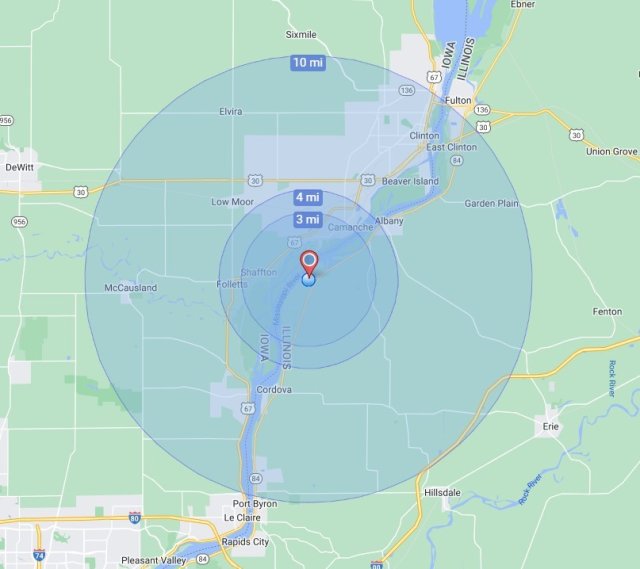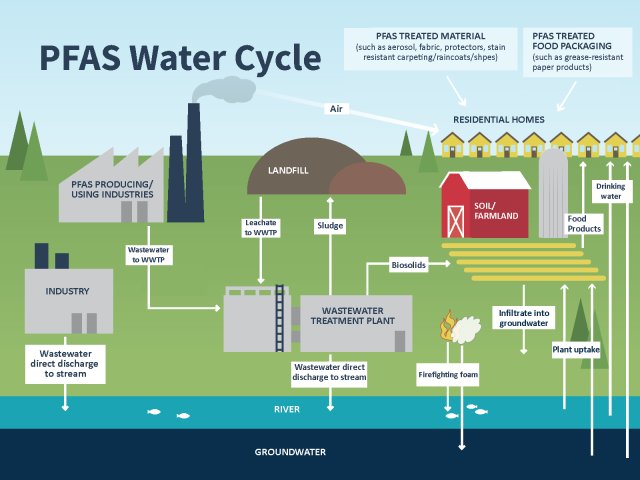3M Cordova
Per- and polyfluoroalkyl substances, collectively called “PFAS,” are a group of man-made chemicals that have been manufactured and used in industry and consumer products since the 1940s. There are thousands of different PFAS chemicals, some of which have been more widely used and studied than others.
For more information, please visit EPA’s PFAS website.
On this page:
- 3M Agrees to EPA Order to Sample Drinking Water
- Why is EPA Taking Action Now?
- What is PFAS?
- Next Steps
- PFAS Can Be Found in Many Places
- What EPA Has Learned About PFAS?
3M Agrees to EPA Order to Sample Drinking Water
The 3M Company agreed to a Administrative Order on Consent - 3M Cordova (pdf) to sample and provide treatment to address contamination from per- and polyfluoroakyl substances (PFAS) found in drinking water in the vicinity of 3M’s Cordova, IL facility. Recent sampling results provided by 3M indicate the widespread presence of a mixture of at least 19 different PFAS chemicals in drinking water within a 3-mile radius of the Cordova facility. Given the unique circumstances affecting this community, including more than five decades of PFAS discharges and the many types of PFAS chemicals found, EPA has concluded that the situation constitutes an imminent and substantial endangerment under the federal Safe Drinking Water Act. (see map below)
Why is EPA Taking Action Now?
3M’s sampling of the drinking water in private wells near the facility detected a range of concentrations including: perfluorooctanoic acid (PFOA) of non-detect to 25 ppt, perfluorooctanesulfonic acid (PFOS) of non-detect to 30 ppt, hexafluoropropylene oxide dimer acid (HFPO-DA), or “GenX” of non-detect to 59 ppt, and perfluorobutane sulfunate (PFBS) of non-detect to 51 ppt. 3M did not use EPA test methods for this sampling. As a result, the order issued today requires 3M to sample these wells again following EPA test methods.
Next Steps

As part of this settlement, 3M is required to offer treatment to all private well owners within 3 miles of the facility and to the Camanche, Iowa Water Supply, in an effort to remove PFAS from the drinking water. 3M is also required to offer drinking water sampling out to 4 miles from the facility for private well owners and out to 10 miles from the facility for public water systems as well as to the Quad Cities’ public water systems, using EPA protocols and conducted under EPA oversight.
PFAS Can Be Found in Many Places
3M was one of the original companies developing and producing PFAS within the United States, and their Cordova facility operations and discharges containing PFAS chemicals date back to the 1970s. 3M’s agreement to the terms of the Order including completing the work required under EPA’s oversight is an important step to begin addressing the problem created by decades of contamination. This settlement is part of EPA’s ongoing efforts to compel major PFAS manufacturers to characterize and control ongoing releases from their facilities.
There are thousands of PFAS chemicals, and they are found in many different industrial, commercial, and household products, including:
- Drinking water – public drinking water systems and private drinking water wells.
- Soil and water at or near waste sites
- At landfills, disposal sites, and hazardous waste sites such as those that fall under the federal Superfund and Resource Conservation and Recovery Act (RCRA) programs.
- Fire extinguishing foam - in aqueous film-forming foams (AFFFs) used to extinguish liquid-based fires. Such foams are used in various emergency responses.
- Manufacturing or chemical production facilities that produce or use PFAS – such as chrome plating, electronics, textile, and paper manufacturers.
- Food – for example in fish caught from water contaminated by PFAS, and dairy products from livestock exposed to PFAS.
- Food packaging – in grease-resistant paper, fast food containers/wrappers, microwave popcorn bags, pizza boxes, and candy wrappers.
- Household products – in stain and water-repellent used on carpets, upholstery, clothing, and other fabrics; cleaning products; non-stick cookware; paints, varnishes, and sealants.
- Personal care products – in certain shampoos, dental floss, and cosmetics.
- Biosolids – for example in treated wastewater that is used on agricultural lands.

This graphic shows the different pathways PFAS can take to contaminate water, soil and food products.
What EPA Has Learned About PFAS
- PFAS are widely used, long lasting chemicals which break down very slowly over time.
- Because of their widespread use and persistence in the environment, many PFAS are found in the blood of people and animals, and are present at low levels in a variety of food products.
- Scientific studies have shown that exposure to some PFAS may be linked to harmful health effects in humans and animals.
- EPA launched the PFAS Strategic Roadmap, a whole-of-agency approach for addressing PFAS.
View a larger version of the PFAS Water cycle (pdf)
The information on this page is also available as a factsheet. Factsheet: EPA Settlement Reached for 3M to Sample and Treat Drinking Water (pdf)
